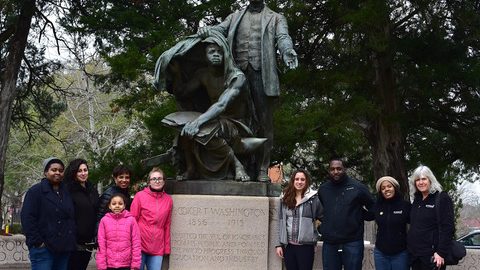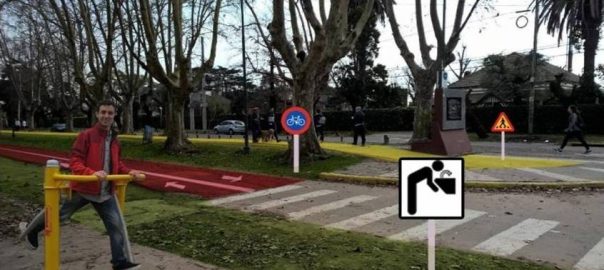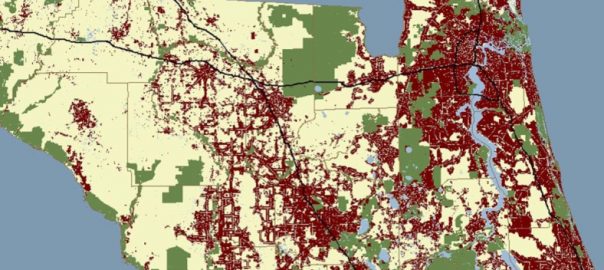In October 2012, Hurricane Sandy slammed into the New York and New Jersey shoreline, with winds of 145 kilometers per hour and a storm surge 4.3 meters above mean low water. The superstorm flooded the city’s subways, destroyed thousands of homes, washed away beaches and boardwalks, and caused at least 53 deaths and over $18 billion in economic losses. On the other side of the world, between 2006 and 2014, Singapore experienced multiple 150-year record rainfalls and droughts. How can cities experiencing climate-related flooding and other disturbances protect their citizens now and into the future?
Climate change education addresses immediate safety and risk reduction, as well as longer-term actions to enhance environmental quality.
Environmental education—including school and public programs developed by universities and government agencies as well as initiatives that emerge from the efforts of grassroots organizations—can play a role in responding to and preparing for climate change and related disasters. But in so doing, environmental educators face a dilemma: how can we hold true to our foundational values of enhancing the environment, including efforts to mitigate climate change, while addressing the reality that climate change has already irreversibly changed our environment and that we need to adapt and transform? We address this question using examples of formal school curricula, engineered infrastructure development, and public outreach in Singapore, and through an exploratory “three Rs” approach to climate responsive environmental and sustainability education in the U.S.
Formal curriculum and infrastructure approach
To see more chapters from the book, click here.
Whereas Singapore’s multi-pronged efforts are impressive, Chang and Irvine (2014) recognize the need for a more integrated approach to prepare the public. For instance, they suggest developing a program to help the public prepare for precipitation extremes by identifying vulnerabilities and risks, creating an understanding of the notion of adaptive capacity (e.g., through improving drainage systems), and monitoring precipitation. They also promote a relief action program that describes what can be done for post-event recovery. In short, Singapore, which similar to many coastal cities around the world is highly vulnerable to sea level rise, has embarked on a comprehensive approach to protect and educate its citizens and can be expected to take on even greater efforts in the future.

Climate-responsive environmental and sustainability education: reclamation, resilience, and regeneration (three Rs)
Education that focuses exclusively on reducing our carbon footprint, or mitigation, is no longer realistic given that changes in climate are already occurring and threatening livelihoods, communities, ecosystems, and biodiversity.
In addition to efforts like those in Singapore that help residents prepare for and respond to the immediate threat of disasters, Hauk (2016) has called for more fundamental rethinking about how we address ongoing climate instability. She had proposed the three Rs approach to climate-responsive environmental and sustainability education. The Rs include reclamation, a form of mitigation or reducing our impact on and improving the environment; resilience, which incorporates notions of adaptation and adaptive capacity; and regeneration, which is most closely aligned with transformation or envisioning new social-ecological processes and systems. We suggest how environmental education can support each of these processes below.
Reclamation
Reclamation involves designing systems to reclaim lost ecological and social capacity. It can include ark-like preservation or conservation via sanctuaries, weather-proof libraries, seed banks, and reserves that maintain cultural lifeways. Whereas we often think of reclaiming in terms of mine reclamation, here we refer to reclaiming more complete sustainable living systems such as those incorporating indigenous ecological knowledge. Innovative technologies, including those informed by deep biomimicry (Mathews 2011), can contribute to reclamation. Because reclamation is driven by an ethic of caring, and by political and social structures that allow for the expression of that caring, it depends on a culture’s commitment to sustainability. Further, because it invites reconsideration of marginalized ecosystems and lifeways, reclamation also depends on the cultural commons, and the continuity and honoring of elder cultures that provide an alternative to practices with a high carbon footprint (Bowers, 2013). While this seemingly excludes the possibility of reclamation for many cities, remnants of social and ecological memories are often retained, for example, by farmers who have immigrated or migrated to urban centers and grow vegetables and herbs in community gardens. Cuba’s permaculture and organic farming revolution and use of appropriate technologies following loss of Soviet support in the 1990s provides an example of reclamation. Such urban agriculture, as well as smaller-scale urban allotment and community gardens, bring together multiple generations and people with different skills, and thus create opportunities for environmental learning.
Resilience
A person, a community, an ecosystem, or a social-ecology system can be resilient. Thus, psychology, sociology, and ecology have developed definitions of resilience, all of which have in common notions of hardship, disturbance, recovery, adaptation, and in cases where an individual, community, or system experiences “tipping point” changes, transformation (Table 1).
| Type of resilience | Definition |
| Community | Ability of communities to cope with and recover from external stressors resulting from social, political and environmental change (CARRI, 2013) |
| Ecological | Magnitude of disturbance that a system can experience before it moves into a different state with different controls on structure and function (Holling, 1973) |
| Psychological | Processes of, capacity for, or patterns of positive adaptation during or following exposure to adverse experiences that have the potential to disrupt or destroy the successful functioning or development of the person (Masten and Obradovic, 2008) |
| Social-ecological systems | Capacity of a social-ecological system to adapt or transform so as to maintain ongoing processes in response to gradual and small-scale change, or transform in the face of devastating change (Berkes, Colding, and Folke, 2003) |
Krasny, Lundholm, and Plummer (2010) suggest four ways in which environmental education programs can contribute to social-ecological and other forms of resilience.
- Environmental education can foster attributes of resilient social-ecological systems such as biological diversity, ecosystem services, and social capital (cf. Walker and Salt, 2006).
- Through collaboration with government agencies and nonprofit and community organizations, environmental education organizations can become part of polycentric governance systems, which offer options for adapting to and bouncing back from small disturbance and major disasters (cf. Ostrom, 2010, cited in Krasny et al. 2010).
- Resilience can help bridge the controversy over whether environmental education is an instrument to promote behavior change, or a means to foster critical thinking and emancipation, by showing that environmental education can foster social-ecological systems (instrumental) and psychological (emancipatory) resilience simultaneously.
- Parallels among concepts from learning theory and social-ecological resilience may contribute to badly needed cross-disciplinary approaches to address linked social and environmental problems. For example, learning theory suggests that discrepant or unexpected events foster transformational learning, and social-ecological systems resilience suggests that major disturbances spur new approaches to environmental management and environmental education.
A study of environmental educators who experienced Hurricane Sandy in New York City revealed that educators commonly used the term resilience to describe their programs. They drew on their environmental education practice to create working definitions of resilience, which roughly mirrored the academic definitions of psychological, community, and social-ecological resilience. A program emphasizing psychological resilience sought to equip participants with the skills to respond to future disturbances; programs designed to support community participation in planning reflected community resilience; and those that fostered engagement in civic ecology practices, such as oyster and dune restoration, reflected social-ecological resilience (DuBois and Krasny, 2016).
Education for adaptation and transformation can foster healthy ecosystem and community processes, consistent with reducing carbon footprint.
Although educators in the New York City study commonly did not make a distinction between resilience and adaptation, they spoke about resilience more often. Possible explanations include being influenced by resilience-focused funding and resilience-related city government reports. But an intriguing possibility is that the notion of resilience as a pathway forward in the face of personal hardship as well as larger systems disturbance made this term resonate with educators. Or, as one educator put it: “Adaptation—sometimes there is a, I don’t want to use the word helplessness—but less of a proactive feeling than resiliency. Resiliency says it’s a pathway and process—the words adaptation and mitigation—not a lot of love in there.”
Regeneration
Regeneration involves creating more fundamental, transformational change, recognizing that climate change is altering ongoing social-ecological processes and that systems may lose the ability to adapt (Hauk, 2016). Such transformations are consistent with the reorganization phase following tipping point disruptions in the adaptive cycle, and with the emergence of entirely new processes at multiple scales (Gunderson and Holling, 2002; Krasny et al, 2010). Similar to resilient systems, regenerative systems are characterized by multiple and multi-scale feedback mechanisms, including feedbacks among social capital, empowerment, urban food production, justice, and knowledge-sharing networks. For example, students engaged in community gardens may build social capital, which in turn may foster willingness to engage in further action for the common good—including actions that require creating new systems for managing collective resources such as urban open space. Urban environmental education can play a role in regeneration not only by helping young people engage in activities such as creating and monitoring artificial algal systems designed to filter contaminants or produce energy, but also by reflecting on the human, community, and ecosystem processes that enable such systems to thrive. We can think of regeneration as “re-weaving living systems.” Williams and Brown (2012, pp. 44-45) argue that these more radically transformative approaches “redesign the mindscape” while restructuring environmental and sustainability education through “the development of a regenerative metaphorical language to inform sustainability teaching and learning.” The learning is characterized by cooperation, mutual reciprocity, and vibrancy, and catalyzes transformations in the structure and pedagogy of learning contexts.
Summing-up
All three Rs—reclamation, resilience, and regeneration—can occur simultaneously. In fact, we may envision them as embedded processes, with reclamation occupying the more limited vision, followed by resilience and finally regeneration. Further, all three processes may depend on horizontal networks of nongovernmental organizations, scientists, government, and community groups that mobilize actions, and vertical integration of community action with larger political structures so as to effect larger changes (Soltesova et al., 2014).
Environmental education can incorporate reclamation, resilience, and regeneration. Environmental education for reclamation occurs when students become involved in preservation, conservation, and the establishment of sanctuaries of exemplar systems, including in small urban parks or gardens. Environmental education for social-ecological resilience focuses on building adaptive capacity, including through creating social networks to support collaboration and learning, which are in turn applied to an ongoing process of collaborative and adaptive management or so-called “learning by experience.” Similar to environmental education for resilience, environmental education for regeneration incorporates an emphasis on feedback processes and nurtures participation in stewardship activities; however it adds a focus on learning through creating entirely new systems, like algal energy production, and on reflecting on how new types of complex systems operate.
The “reclamation, resilience, and regeneration” climate education framework encompasses learning about mitigation, adaptation, and transformation.
Conclusion
Returning to our original question about the challenges environmental education faces in an age of climate change, we contend that environmental education can integrate mitigation and adaptation in cases where adaptation is grounded in processes that occur in healthy ecosystems and communities (Krasny and DuBois, in press). Examples of so-called “ecosystem-based adaptation” include restoring populations of oysters that provide filtering and other ecosystem services, and restoring dunes to serve as natural barriers for storm surges. Environmental education also can address adaptation in a manner consistent with its social values, including participation and equity, by incorporating “community-based adaptation” options. These include efforts to engage youth and adults in collaborative, hands-on stewardship and monitoring. Although many such initiatives may not sound like environmental education per se, we propose a definition of urban environmental education that in addition to structured lessons, encompasses the learning that occurs through engagement in hands-on reclamation, restoration, and creating or monitoring regenerative systems. In some cases, this will mean that engagement in restoration and other forms of stewardship, normally considered a goal of environmental education, occurs prior to and creates a context for learning.
How might we integrate environmental education alongside mitigation, adaptation, and transformation, and the three Rs climate responsive education? We can start by drawing on a long-term tradition of environmental education that has focused on mitigation. When efforts to foster pro-environmental behaviors address conservation, environmental education is consistent with the first R, reclamation. Climate responsive environmental education expands to encompass ecosystem- and community-based adaptation, which is consistent with the second R, resilience. Finally, climate responsive environmental education encompasses transformation or regeneration, the third R (Table 2). Although we refer here to social-ecological resilience and transforming social-ecological systems, environmental education also fosters psychological resilience and transforms individual lives. Both individual and social-ecological systems resilience and transformation are critical to addressing climate change.
| Climate Response Categories | three Rs | Examples |
| Mitigation | Reclamation | Preserves that incorporate indigenous knowledge, seed banks |
| Adaptation | Resilience | Ecosystem- and community-based adaptation (e.g., dune restoration) |
| Transformation | Regeneration | “Reweaving” new systems (e.g., algal energy production system) |
In this chapter, we present two paradigms for climate change education in cities. The first is based on the real-life experience of Singapore, a small, coastal city-state in constant risk of flooding whose options are limited by its size and location. Here, a more government-directed approach to ensure the safety of individuals and their water supply has been successful in saving lives.
The three Rs tries to move beyond existing ways of thinking and political structures that reinforce social and economic injustices and environmental degradation. It also suggest moving beyond top-down control strategies for emergency preparedness, despite the fact that such strategies may be desperately needed to save lives and infrastructure in the short run. Finding the balance between real-time responsiveness to ensure safety and save human lives, stewardship action coupled with reflection and integrated understandings of social-ecological systems, and long-term capacity building to create transformed energy and social systems, is a critical challenge facing environmental education as we address social and ecological changes brought about by a warming and more erratic climate.
Marianne Krasny, Chew-Hung Chang, Marna Hauk, and Bryce DuBois
Ithaca, Singapore, Portland, and New York City
* * * * *
This essay will appear as a chapter in Urban Environmental Education Review, edited by Alex Russ and Marianne Krasny, to be published by Cornell University Press in 2017. To see more pre-release chapters from the book, click here.
References
Berkes, F., Colding, J. and Folke, C. (2003). Navigating social-ecological systems: Building resilience for complexity and change. Cambridge, UK: Cambridge University Press.
Bowers, C.A. (2013). The role of environmental education in resisting the global forces undermining what remains of indigenous traditions of self-sufficiency and mutual support. In Kulnieks, A. Longboat, D.R., and Young, K. (Eds.), Contemporary studies in environmental and indigenous pedagogies: A curricula of stories and place (pp. 225-240). Rotterdam: Sense Publishers.
CARRI. (2013). Definitions of community resilience: An analysis (pp. 14): Community and Regional Resilience Institute.
Chang, C.H. (2014). Is Singapore’s school geography becoming too responsive to the changing needs of society? International Research in Geographical and Environmental Education, 23(1), 25-39.
Chang, C.H. and Irvine, K.N. (2014). Climate change resilience and public education in response to hydrologic extremes in Singapore. British Journal of Environment and Climate Change, 4(3), 328-354.
DuBois, B. and Krasny, M. E. (2016). Educating with resilience in mind: Addressing climate change in Post-Sandy New York City. Journal of Environmental Education.
Gunderson, L. H. and Holling, C. S. (Eds.). (2002). Panarchy: Understanding transformations in human and natural systems. Washington DC: Island Press.
Hauk, M. (2016). The new “three Rs” in an age of climate change: Reclamation, resilience, and regeneration as possible approaches for climate-responsive environmental and sustainability education. Journal of Sustainability Education, 7(2).
Holling, C.S. (1973). Resilience and stability of ecological systems. Annual Review of Ecology, Evolution, and Systematics, 4, 1-23.
Krasny, ME and B DuBois. (in press). Climate Adaptation Education: Embracing Reality or Abandoning Environmental Values? Environmental Education Research.
Krasny, M.E., Lundholm, C. and Plummer, R. (2010). Resilience, learning and environmental education. Environmental Education Research (special issue), 15(5-6), 463-672.
Masten, A.S. and Obradovic, J. (2008). Disaster preparation and recovery: Lessons from research on resilience in human development. Ecology and Society, 13(1), 9.
Soltesova, K., Brown, A., Dayal, A. and Dodman, D. (2014). Community participation in urban adaptation to climate change: Potentials and limits for community-based adaptation approaches. In Schipper, E.L.F., et al. (Eds.), Community-based adaptation to climate change: Scaling it up (pp. 214-225). New York: Routledge.
Walker, B. H. and Salt, D. (2006). Resilience Thinking: Sustaining Ecosystems and People in a Changing World. Washington, DC: Island Press.
Williams, D. and Brown, J. (2012). Learning gardens and sustainability education: Bringing life to schools and schools to life. New York: Routledge.
about the writer
Chew-Hung Chang
Dr. Chang Chew Hung is concurrently the Associate Dean for Professional Development, at the Office of Graduate Studies & Professional Learning,and an Associate Professor of Geography Education with the Humanities and Social Studies Education Academic Group, National Institute of Education, Nanyang Technological University, Singapore.
about the writer
Marna Hauk
Marna Hauk, Ph.D., is a professor, regenerative designer, and collaborative creativity catalyst. She innovates experiential educational programs for wild Gaian thriving.
about the writer
Bryce Dubois
Bryce DuBois is a doctoral candidate in the Environmental Psychology program at the City University of New York. Bryce is also an Extension Associate with the Civic Ecology Lab in the department of Natural Resources at Cornell University (PI: Marianne Krasny).







Leave a Reply